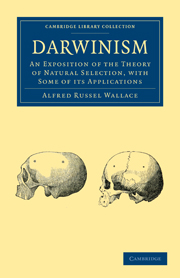Book contents
- Frontmatter
- Preface
- Contents
- LIST OF ILLUSTRATIONS
- CHAPTER I WHAT ARE “SPECIES” AND WHAT IS MEANT BY THEIR “ORIGIN”
- CHAPTER II THE STRUGGLE FOR EXISTENCE
- CHAPTER III THE VARIABILITY OF SPECIES IN A STATE OF NATURE
- CHAPTER IV VARIATION OF DOMESTICATED ANIMALS AND CULTIVATED PLANTS
- CHAPTER V NATURAL SELECTION BY VARIATION AND SURVIVAL OF THE FITTEST
- CHAPTER VI DIFFICULTIES AND OBJECTIONS
- CHAPTER VII ON THE INFERTILITY OF CROSSES BETWEEN DISTINCT SPECIES AND THE USUAL STERILITY OF THEIR HYBRID OFFSPRING
- CHAPTER VIII THE ORIGIN AND USES OF COLOUR IN ANIMALS
- CHAPTER IX WARNING COLORATION AND MIMICRY
- CHAPTER X COLOURS AND ORNAMENTS CHARACTERISTIC OF SEX
- CHAPTER XI THE SPECIAL COLOURS OF PLANTS: THEIR ORIGIN AND PURPOSE
- CHAPTER XII THE GEOGRAPHICAL DISTRIBUTION OF ORGANISMS
- CHAPTER XIII THE GEOLOGICAL EVIDENCES OF EVOLUTION
- CHAPTER XIV FUNDAMENTAL PROBLEMS IN RELATION TO VARIATION AND HEREDITY
- CHAPTER XV DARWINISM APPLIED TO MAN
- INDEX
CHAPTER V - NATURAL SELECTION BY VARIATION AND SURVIVAL OF THE FITTEST
Published online by Cambridge University Press: 29 August 2010
- Frontmatter
- Preface
- Contents
- LIST OF ILLUSTRATIONS
- CHAPTER I WHAT ARE “SPECIES” AND WHAT IS MEANT BY THEIR “ORIGIN”
- CHAPTER II THE STRUGGLE FOR EXISTENCE
- CHAPTER III THE VARIABILITY OF SPECIES IN A STATE OF NATURE
- CHAPTER IV VARIATION OF DOMESTICATED ANIMALS AND CULTIVATED PLANTS
- CHAPTER V NATURAL SELECTION BY VARIATION AND SURVIVAL OF THE FITTEST
- CHAPTER VI DIFFICULTIES AND OBJECTIONS
- CHAPTER VII ON THE INFERTILITY OF CROSSES BETWEEN DISTINCT SPECIES AND THE USUAL STERILITY OF THEIR HYBRID OFFSPRING
- CHAPTER VIII THE ORIGIN AND USES OF COLOUR IN ANIMALS
- CHAPTER IX WARNING COLORATION AND MIMICRY
- CHAPTER X COLOURS AND ORNAMENTS CHARACTERISTIC OF SEX
- CHAPTER XI THE SPECIAL COLOURS OF PLANTS: THEIR ORIGIN AND PURPOSE
- CHAPTER XII THE GEOGRAPHICAL DISTRIBUTION OF ORGANISMS
- CHAPTER XIII THE GEOLOGICAL EVIDENCES OF EVOLUTION
- CHAPTER XIV FUNDAMENTAL PROBLEMS IN RELATION TO VARIATION AND HEREDITY
- CHAPTER XV DARWINISM APPLIED TO MAN
- INDEX
Summary
In the preceding chapters we have accumulated a body of facts and arguments which will enable us now to deal with the very core of our subject—the formation of species by means of natural selection. We have seen how tremendous is the struggle for existence always going on in nature owing to the great powers of increase of all organisms; we have ascertained the fact of variability extending to every part and organ, each of which varies simultaneously and for the most part independently; and we have seen that this variability is both large in its amount in proportion to the size of each part, and usually affects a considerable proportion of the individuals in the large and dominant species. And, lastly, we have seen how similar variations, occurring in cultivated plants and domestic animals, are capable of being perpetuated and accumulated by artificial selection, till they have resulted in all the wonderful varieties of our fruits, flowers, and vegetables, our domestic animals and household pets, many of which differ from each other far more in external characters, habits, and instincts than do species in a state of nature. We have now to inquire whether there is any analogous process in nature, by which wild animals and plants can be permanently modified and new races or new species produced.
Effect of Struggle for Existence under Unchanged Conditions.
Let us first consider what will be the effect of the struggle for existence upon the animals and plants which we see around us, under conditions which do not perceptibly vary from year to year or from century to century.
- Type
- Chapter
- Information
- DarwinismAn Exposition of the Theory of Natural Selection, with some of its Applications, pp. 102 - 125Publisher: Cambridge University PressPrint publication year: 2009First published in: 1889
- 1
- Cited by



